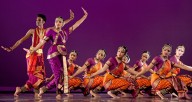UPDATE: The new seechicagodance.com will launch March 31st. Click here to learn more.
Cross-cultural connection and collaboration at the heart of Natya Dance Theatre’s newest work
The evening began with a dark stage, only a small puppet visible. The puppet, who foreshadowed a larger-than-life puppet to come, appeared to speak as a woman’s voice radiated through the theater: “The struggle is not between ourselves, but within us.” In this moment of modern performance mixed with sage advice, the audience was transported into a story that although mystical in experience, brought to life the very-real division that plagues our world today while advocating for the kind of change that starts in our everyday lives.
With “Inai—The Connection,” running Nov 7-9 at the Dance Center at Columbia College Chicago, Natya Dance Theatre (NDT) connected eastern and western philosophies, traditional bharatanatyam and contemporary performance, and artists with roots in both the United States and India. At a time when communities in the United States seem to be rapidly isolating themselves politically and culturally, NDT’s newest work integrated live music, puppetry and intricate choreography to urge audiences to break down the metaphorical and physical barriers that separate us locally, nationally and internationally.
Fusing centuries-old eastern philosophy into modern-day solutions, dancers and co-choreographers Hema Rajagopalan and Astad Deboo pointed towards the inner conflict residing in each individual, or ego, as the source of the barriers isolating society today. Through a series of vignettes outlining personal, communal and religious barriers, they advocated that individuals take responsibility for their inner egos in order to find solutions to conflicts between families, communities and nations.
Natya Dance Theatre, founded by Rajagopalan in 1974 in Chicago, is known for preserving traditional bharatanatyam (a classical Indian dance form that illustrates hindu religious themes and ideas), while also integrating contemporary elements into their dance theatre works to engage broad audiences in critical thought about today’s global world. For “Inai—The connection,” NDT collaborated with vocalist Sikkil Gurucharan, who is based in India, and contemporary Indian dance innovator Astad Deboo, also based in India, who involved his own music, dance and puppeteer collaborators in the project.
In “Inai—The Connection,” traditional bharatanatyam is experienced through the traditional song lyrics—dating back centuries as Rajagopalan noted in the talkback—as well as the percussive footwork, evocative facial expressions and intricate hand gestures or mudras that hold symbolic meaning. Through the use of contemporary elements such as puppetry, saxophone (played by George Brooks) and athletic movement and partnering, NDT moves audiences through a mystical and sensory experience that holds modern-day significance.
In the vignette on religious barriers, all of these elements come together in what becomes the most powerful ensemble choreography of the piece. One dancer separates themselves from the ensemble, performing a series of gestures that represent a different religious practice. The rest of the ensemble begins to notice this outsider, evident in their facial gestures and eye movement. The ensemble then retaliates against this solo dancer—using full-bodied jumps, arm motions and floor patterns to dispel each outcast dancer to the edge of the stage. Each time the ensemble rejects a dancer for their religious beliefs, the large puppet figure (played by puppeteer Pawan Wagamare) envelops the rejected in a comforting embrace.
It is in these moments where traditional and contemporary movements are blended and human dancers interact with the puppet that I as an audience member felt the most moved towards inner and outer compassion. Particularly in this section, where the puppet is fully integrated into the ensemble choreography (as opposed to much of the rest of the piece where the puppet is separated from the other dancers), the puppet, who Rajagopalan noted in the post-show discussion represented consciousness, captivated the audience in a deity-like air of magic while reminding us of the impact of the timeless virtue of unity.
In between ensemble dancing, Rajagopalan and Daboo took hold of the stage in a series of solos and duets where they seemed to take on the human form of consciousness seen in the puppet. It was a treat to watch these two experts move together: Daboo’s (whose roots are in kathak dance) smooth arm sways and airy leg lifts, juxtaposed by Rajagopalan’s percussive footwork and sharper arm gestures. With deep facial expressions, the two conveyed honest concern for the division occurring on stage.
Through a work that relied on cross-cultural collaboration to bring myriad contrasting elements together, Natya Dance Theatre gathered a diverse audience. Those unfamiliar with bharatanatyam gained appreciation and understanding for the art form through connections with urgent, contemporary themes, and those familiar with bharatanatyam traditions found appreciation and understanding for contemporary dance forms through connections with timeless themes that resonate today.
--
“Inai—The Connection” runs through Nov 9 at the Dance Center at Columbia College Chicago, 1306 S Michigan Ave. Tickets range $10-$30, available by clicking the event link below.


